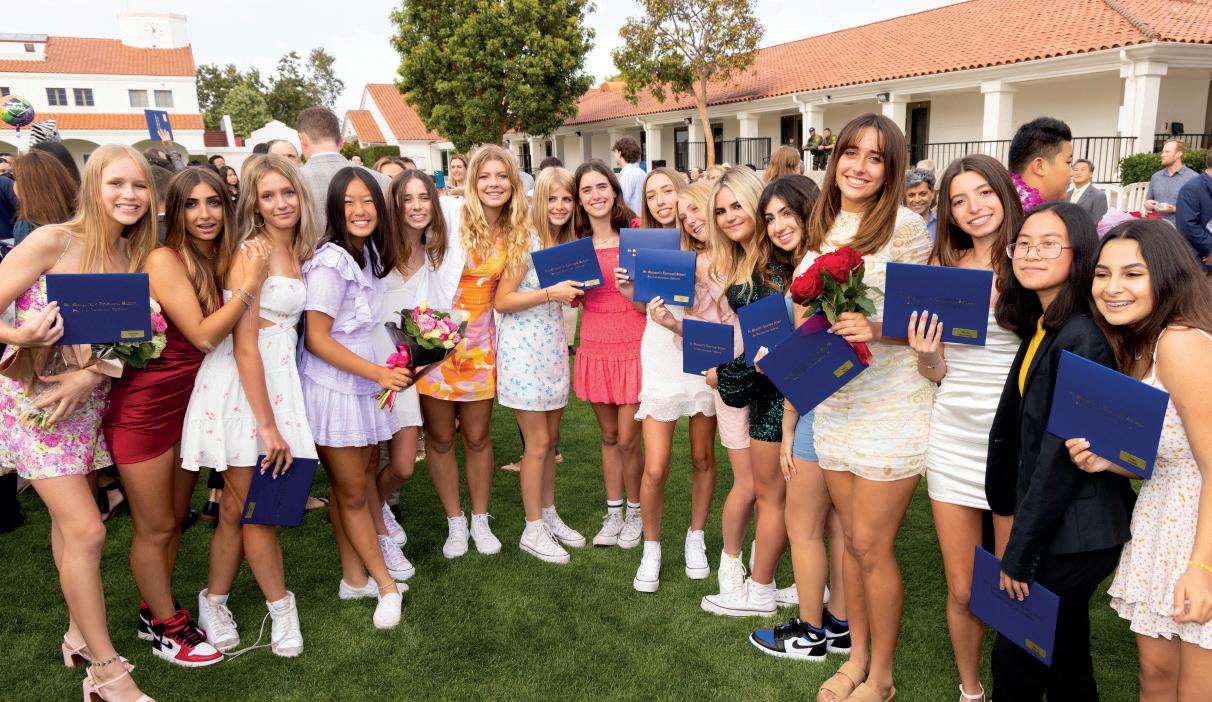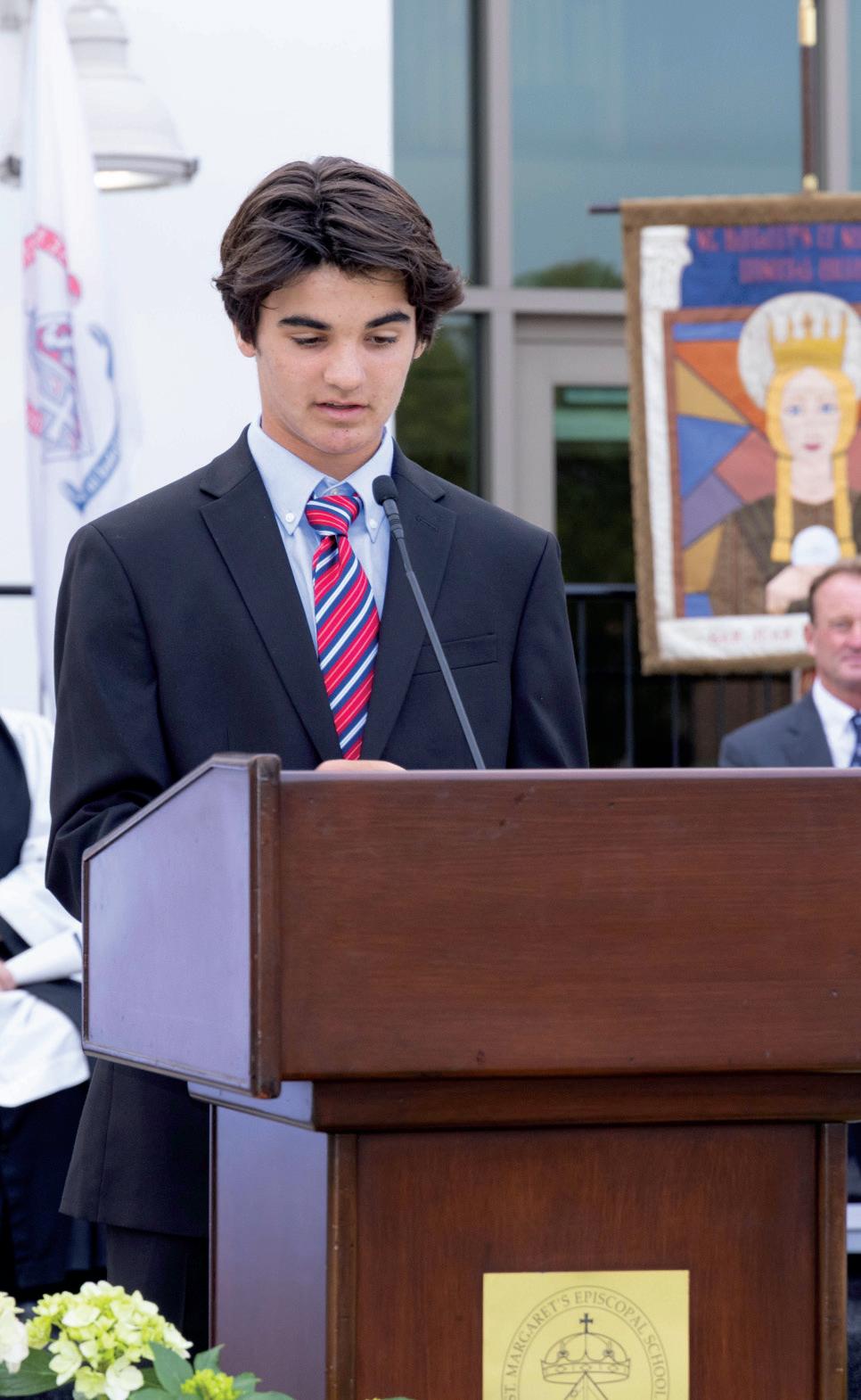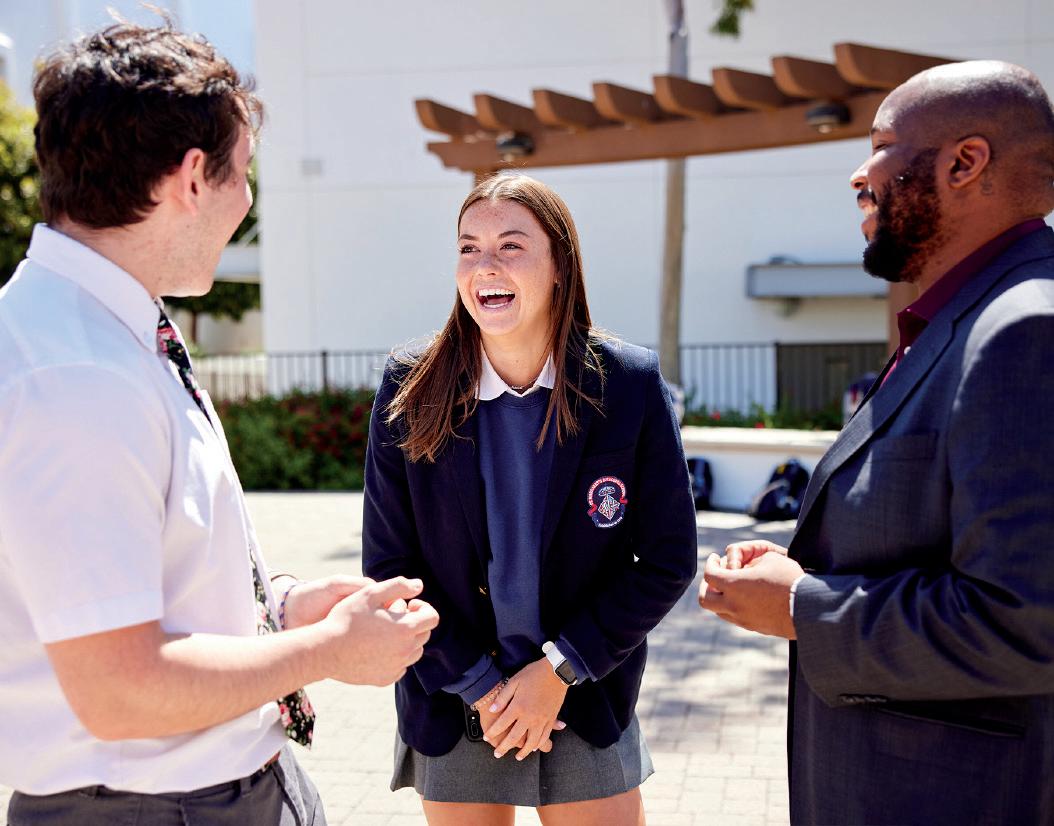
32 minute read
PERSPECTIVE
Why Proactive Health and Well-Being Student Programs? Because They Foster Healthy, Happy, Productive Tartans for Life
BY PATRICK BENDZICK Executive Director of Community Health, Well-Being and Athletics
For most students, thinking about their future health and well-being in relation to their current health decisions and lifestyle choices and habits, is an ambiguous exercise. One of the many eye-opening aspects of the COVID-19 pandemic, however, has been that young people witnessed how adverse health situations could immediately impact their own quality of life in tangible and sudden ways. They saw firsthand that consequences can be both acute and chronic, and it sparked in them a greater appreciation for physical and mental health.
This awareness is both positive and an important opportunity when you consider that during the pandemic, young people across the nation suffered social and emotional health issues at high rates. According to the American Academy of Pediatricians, children and adolescents have experienced “soaring rates” of mental health challenges over the course of the pandemic brought on by enormous adversity and disruption, which only exacerbated the situation that existed previously. In October 2021, the AAP along with the American Academy of Child and Adolescent Psychiatry and Children’s Hospital Association declared a National State of Emergency in children’s mental health.
In December 2021, U.S. Surgeon General Dr. Vivek Murthy followed, issuing a similar advisory about the urgent need to address the nation’s youth mental health crisis. “As the nation continues the work to protect the health and safety of America’s youth during this pandemic, the U.S. Surgeon General outlines the pandemic’s unprecedented impacts on the mental health of America’s youth and families, as well as the mental health challenges that existed long before the pandemic,” Dr. Murthy said. The U.S. Department of Health and Human Services reports that before the pandemic, mental health challenges were the leading cause of poor life outcomes in young people, with up to one in five children ages 3 to 17 in the U.S. having a mental, emotional, developmental or behavioral disorder.
While we need to continue to heed these serious trends, St. Margaret’s commitment to student health and well-being has long been a priority of the school. An abundance of proactive programs, systems and resources are already in place to nurture lifelong good health and well-being as well as to support life’s health challenges that our young people could face along the way.
Since the early days of the pandemic, St. Margaret’s was committed and made it possible to sustain many student programs, including having every student back on campus full time, connecting with peers and adults as early as the fall of 2020. This was a tremendously valuable achievement to student health and wellbeing while many young children around the nation and the globe learned in a remote setting for well over a year.
Additionally, St. Margaret’s was already well aligned with the national guidance for schools and youth programs issued in 2021, as a result of making health and well-being a strategic priority with the implementation of many innovative systems, approaches and programs we developed at St. Margaret’s over the last five years. The national guidance included: • Recognize that mental health is an essential part of overall health. • Support the mental health of children and youth in educational, community, and childcare settings. • Expand and support the early childhood and education workforce. • Empower youth to recognize, manage, and learn from difficult emotions. • Provide access to high-quality and culturally competent mental health care. • Support community-based systems of care that connect families in need of behavioral health services and supports for their child with evidence-based interventions in their home, community or school. Our mission calls on us to focus on the “lives of” our students. We believe that student health and well-being is within the responsibility of the school in partnership with our families. Our students spend most of the waking hours with us during the school year, and what happens here every day is not just academic learning; it’s about the complete growth and development of young people. We know if they are well in mind, body and spirit, they can live up to their full potential.
Accordingly, St. Margaret’s takes a holistic approach to health and well-being to support students as they learn and grow in a school community, including physical, social, emotional, academic, psychological, neurological and
spiritual health. How this manifests itself is as unique as the individual, so approaching the issue from a variety of angles and utilizing many resources are essential.
This is where St. Margaret’s unique mission, values, strengths and differentiators enable us to care for the individual student. These include our school size, small classes, low studentto-teacher ratio, preschool through grade 12 school environment, boundless opportunities to engage, and family participation in the life of the school, paired with a dedicated, caring expert professional community that collectively strives to know and love every student in our community.
Additionally, we have designated professional roles across the school whose sole purpose is to safeguard the health and well-being of our community: school psychologists, counselors, registered nurses, physical fitness and conditioning educators, trainers and coaches, chaplains, and cognitive and behavioral experts. Representative leaders of this group regularly meet as a Student Support Team, consult each other and work together across the school to know the community and lead health and well-being programs. This creates an advantageous culture of health and well-being experts working together with a professional community to intentionally care and look out for young people.
Our school systems allow us to work closely with students and families, to get to know them and build trust over many years, learning their personal situations, health challenges and goals, as well as simply recognizing a change in them early that might signal something is going on that needs to be supported. This is an immeasurable benefit to the life of every student as we partner with parents to help children grow and thrive.
These professionals (see sidebar) oversee a proactively integrated host of student programs and systems that leverage successful strategies for nurturing health and well-being, including education, advisory, mentorship and counseling, character and purpose development, personal fitness, spiritual practice, community, inclusion and belonging. St. Margaret’s is well poised to keep our strategic priority of student health and well-being at the forefront and moving forward in exciting and productive ways. This year we have restructured our counseling team to add a third full-time counselor, so that we have one counselor dedicated to each division—partnering with faculty and being the resident expert on the age groups.
In close collaboration with equity and inclusion initiatives, we are working to better understand how identity and cultural backgrounds intersect with matters of personal health to better know and support students.
We will also continue our practice of looking to other leading institutions and programs, typically at the collegiate level, to learn and tap leading practices to further innovate here. With the Student Commons facility planned for the future (see page 22), serving as a hub of student well-being, we will be able to better collaborate, resource, prioritize and expand these programs in the future.
This is a lifelong priority for St. Margaret’s. We will continue to learn from research and trends for our students to learn about, practice and develop proactive healthy habits across the spectrum of well-being along with a personal toolkit of skills for dealing with life’s challenges. This will prepare them to go beyond St. Margaret’s and live healthy and fulfilling lives, connecting with others in trusting relationships, finding purpose and meaning, and contributing to others and community in positive, healthy and successful ways.
The holistic approach
to student health and well-being is implemented by weaving the content through the various experts of each division to meet individual student needs and create relevance.
CHALKBOARD-USER TEACHERS: Create strong and trusting relationships in advisory, innovation blocks, coaching and tutoring.
BOOK-OPEN-READER STUDENTS: Provide peer support in advisory, peer pals, friendship circle and affinity groups.
�� COUNSELORS: Support our families in individual social-emotional learning, educational programming, crisis management and access to outside experts.
USER-EDIT EDUCATIONAL THERAPISTS: Provide support in the form of Student Study Team meetings, neuropsychological/psychoeducational assessments and Academic Support Plans.
USER-NURSE NURSES: Support the physical welfare of students and help make connections to social-emotional services.
⛪ CHAPLAINS: Provide spiritual growth, development and exploration.
⚖ EQUITY TEAM: Create a sense of community and belonging for all students and provide cultural and language support when needed.
HAND-HOLDING-HEART DIRECTORS OF COMMUNITY LIFE: Provide character-and-purpose building engagement opportunities in service learning, leadership groups, retreats, and activities.
�� SECURITY STAFF: Maintain a physical environment where students feel safe and cared for.
STRATEGIC PLAN UPDATE
Listening to All Tartans to Innovate St. Margaret’s Around Strategic Priorities
BY ANNE DAHLEM
St. Margaret’s unique Innovation Strategy calls on every professional community member to put students and their needs at the center of all planning for new programs and initiatives, especially around the school’s highest priorities.
With good reason, the school’s pandemic response has been the highest strategic priority since March 2020, with the rapid iteration and successful application of myriad new academic, health, well-being and campus safety initiatives to support continued learning and growth for all students.
During the 2021-2022 school year, the professional community also revisited other designated strategic priorities, including those identified during the previous CAIS Accreditation Future Planning work through the lens of postpandemic student needs.
The professional community, once again, organized in self-selected teams around the priority areas and utilized the innovation strategy process rooted in Design Thinking to listen to student feedback and identify needs. This time around, though, St. Margaret’s expanded the focus to include the needs of school families and professional community members as well.
“Our Innovation Strategy is rooted in understanding and enhancing the experience of our ‘end users,’ who are primarily the students at the heart of our mission,” said Assistant Head of School Ryan Dahlem. “Yet, St. Margaret’s is having a profound impact on the lives of all its community members. We also recognize the vital importance of the professional community and school families as end users, and intentionally expanded this round of ethnographic research to better understand and design for their needs as well.”
Innovation Strategy teams sought to hear feedback and identify needs for which they will design solutions within seven priorities. They
looked at them by division, and schoolwide, with different members focused on students, parents and colleagues:
1. Curriculum and Pedagogy 2. Professional Development 3. Diversity, Equity and Inclusion 4. Experiential and Service Learning 5. Health and Well-Being 6. Technology 7. Methods for Student Feedback
Before embarking on ethnographic research, which is a highly interactive qualitative research method for collecting data and gleaning insights about community members’ lived experiences, St. Margaret’s dedicated a professional community in-service day for these teams to meet and discuss language used to describe each of the priorities and review the action steps identified for each priority before the pandemic. Teams met first by division or offices, then came together in each priority area to provide an allschool overview.
During the following professional community in-service day, teams met again to design their ethnographic research approach, including a consistent bank of open-ended questions.
The truly inspiring and eye-opening work occurred in the spring when the entire professional community conducted, analyzed and documented insights and findings of more than 180 one-on-one ethnographic interviews with students, parents and colleagues across the school community. On average, these interview meetings take about 45 minutes of thoughtful listening and follow-up questions to learn more.
“A byproduct of this important work was the opportunity for reconnection that our community was craving after being distanced during the pandemic. Students, colleagues and families were seen, heard and valued through the enormous research efforts of our professional community,” said Mr. Dahlem. Some Tartans dug even deeper and completed immersive observations in the school setting through student shadow experiences, which involved experiencing the school through the student perspective for an entire day. The entire kindergarten faculty, for example, shadowed P4 Early Childhood School students to better understand and inform the design of the transition experience of rising kindergarten students.
Team leaders analyzed all the findings and collaborated to identify overarching themes in the qualitative research findings with an allschool perspective.
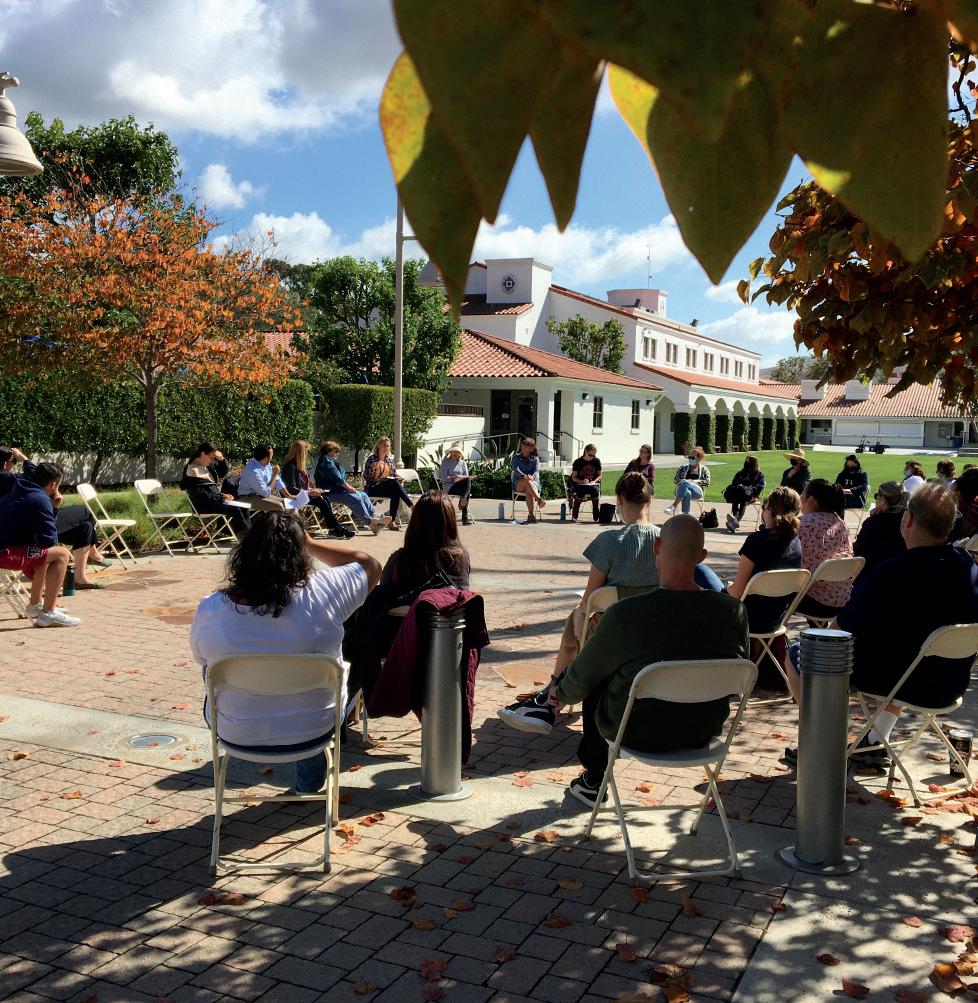
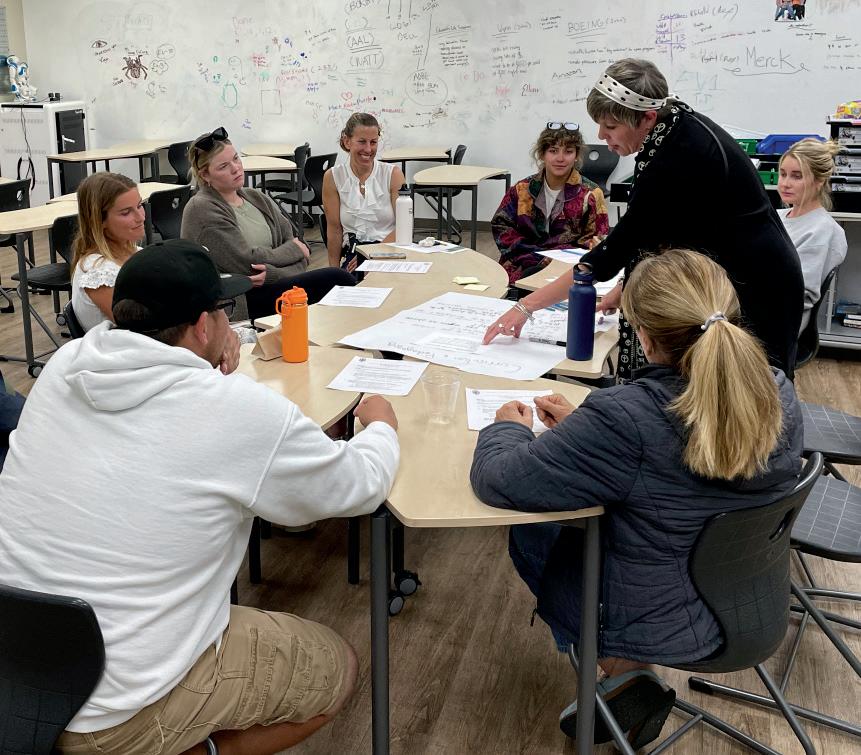
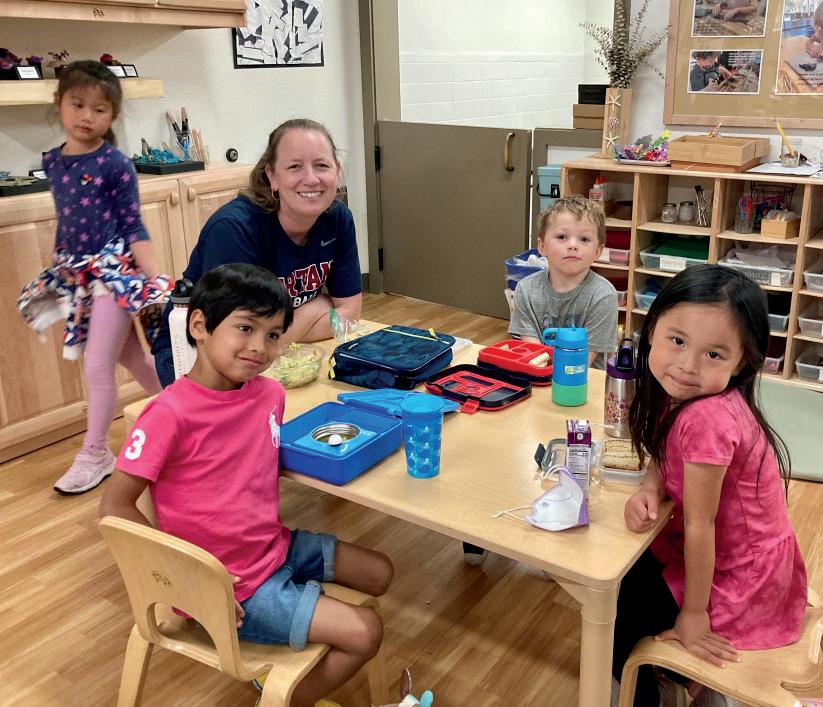
"Our innovation strategy is rooted in understanding and enhancing the experience of our ‘end users,’ who are primarily the students at the heart of our mission... We also recognize the vital importance of the professional community and school families as end users, and intentionally expanded this round of ethnographic research to better understand and design for their needs as well.”
POSITIVE FEEDBACK on general strategic direction. Teams affirmed the work accomplished in priority areas, and interviews supported progress while identifying new needs to meet. Much of the discussion and feedback related to deepening commitments in these areas and updating language on how the school describes this work.
CHOICE. This topic arose in many of the facilitator debrief sessions and was highlighted as an area the school is pursuing and should continue to explore. Examples ranged from the academic program to servicelearning opportunities to professional development. In each, the opportunity for choice is desired and adds meaning and motivation.
EXPANSION. Several teams discussed expanded thinking regarding which end users these initiatives apply to. Examples included expanding health and wellbeing initiatives beyond students to the entire school community and expanding professional development beyond the teaching faculty.
HEALTH AND WELL-BEING. The backdrop of the pandemic was evident across priority areas and heightened the need to understand life outside of school (homework and scheduled commitments for students; work-life balance for adults) and a commitment to DEI (diversity, equity and inclusion) and SEL (social and emotional learning) work that is so relevant to the health and wellbeing of community members.
CONNECTION. There is a strong desire for connection across the school community, including the return of family members to campus and connections across divisions and offices for students and the professional community.
2022-2023 Goals
From the team findings, the academic leadership created three mission-oriented school year goals to guide and focus this work for the school year:
1LEARNING GOAL: RENEW OUR FOCUS ON LIVES OF LEARNING
• Refine the Faculty Growth and Support Plan, including the Essential Beliefs and
Teaching Philosophy, that underpins St. Margaret’s approach to teaching and learning and inspires continuous improvement and innovation. • Design learning experiences that are responsive to student input regarding choice, relevance and well-being. • Expand professional development to further the talents of all professional community members.
2LEADERSHIP GOAL: DEEPEN CONNECTIONS TO OUR EPISCOPAL IDENTITY
• Pursue shared understanding of St. Margaret’s Episcopal Identity in relationship to the school’s Mission and Core Values.
• Explore and advance the intersection of St. Margaret’s Episcopal Identity with health and well-being initiatives and diversity, equity and inclusion work. • Boldly affirm that Episcopal schools exist not merely to educate, but to demonstrate and proclaim the unique worth and beauty of all human beings.
3SERVICE GOAL: NOURISH HUMAN CONNECTIONS AT THE HEART OF OUR COMMUNITY
• Increase opportunities for formal and informal gatherings on campus that enhance connections within the school community. • Deepen relationships with the local community through partnership, engagement, collaboration and service learning. • In all interactions, be guided by an authentic desire to connect and embody the spirit of “I see you.”
Over the course of several professional community in-service days this school year, the teams will revisit action steps generated during the CAIS Accreditation Future Planning process with new information and insights gathered from the community in the spring. They will then engage in the prototype, testing and piloting phases of the design cycle by divisions and offices to generate new solutions and programs for students and the entire St. Margaret’s community, which will continue to advance St. Margaret’s, its mission and the nurturing, vibrant learning experience for all Tartans.
A Center of Student Well-Being: the student Commons
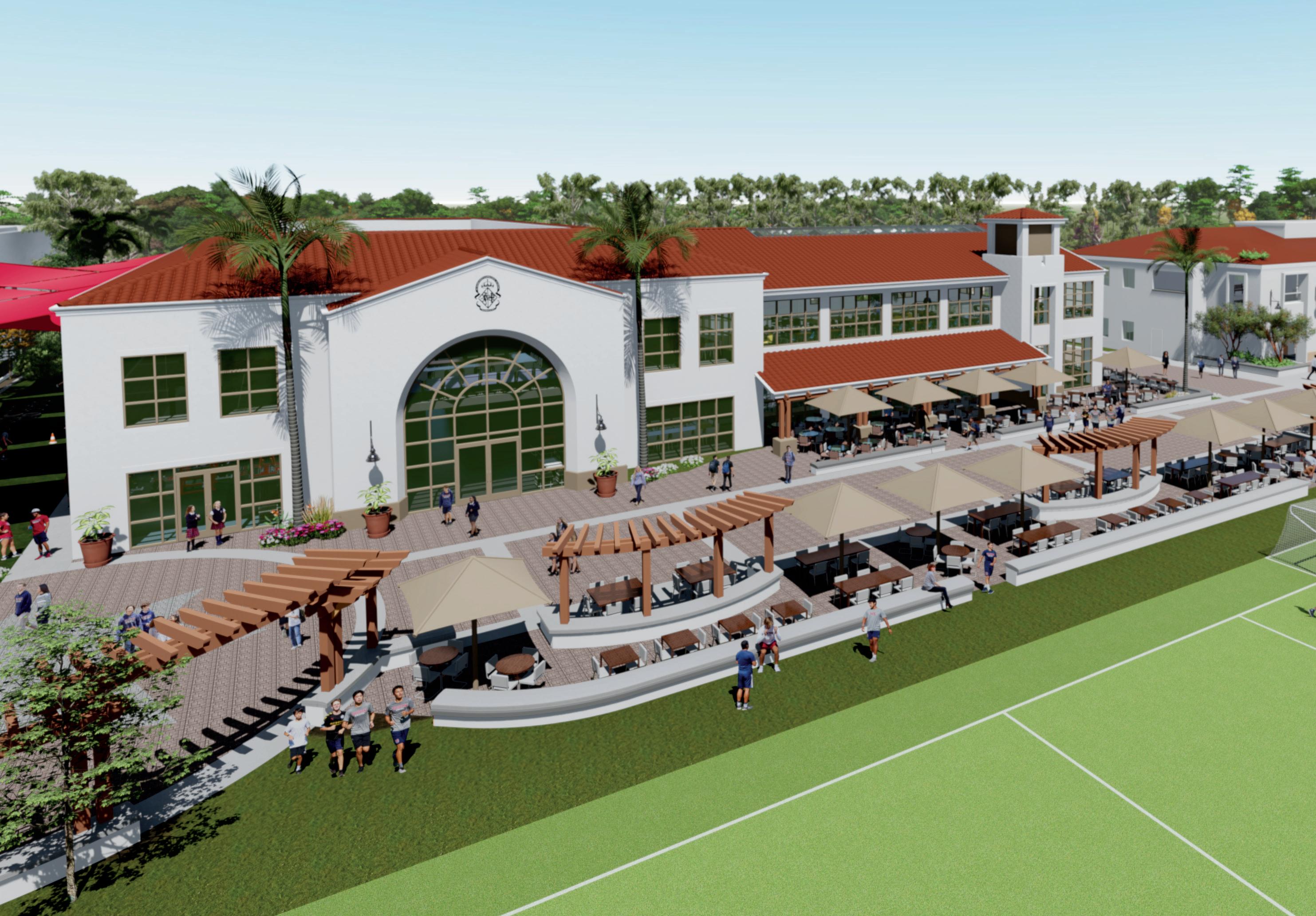
St. Margaret’s Next Campus Priority: Featuring Dining Hall and Expanded Fitness Center
BY ANNE DAHLEM
In the coming school year, St. Margaret’s will relaunch its next major campus master plan project and capital campaign, which aligns with its ongoing school-wide priority on student health and well-being. Announced in the fall of 2019, the Student Commons, a state-of-the art, 30,000-square-foot, two-story building situated on the west side of the Highlands Quad and Chalmers Field, will serve the wellbeing, learning and growth of all Tartans.
A FROM-SCRATCH KITCHEN will serve the entire student body, early childhood through grade 12, with on-site chefs preparing fresh, nutritious and student-friendly foods and meals throughout the day. A great hall with vaulted ceilings and an abundance of natural light will be a central location for student dining and other community gatherings. Centered between the Middle School and Upper School campuses, the Commons will open onto the Highlands Quad and feature outdoor seating areas.
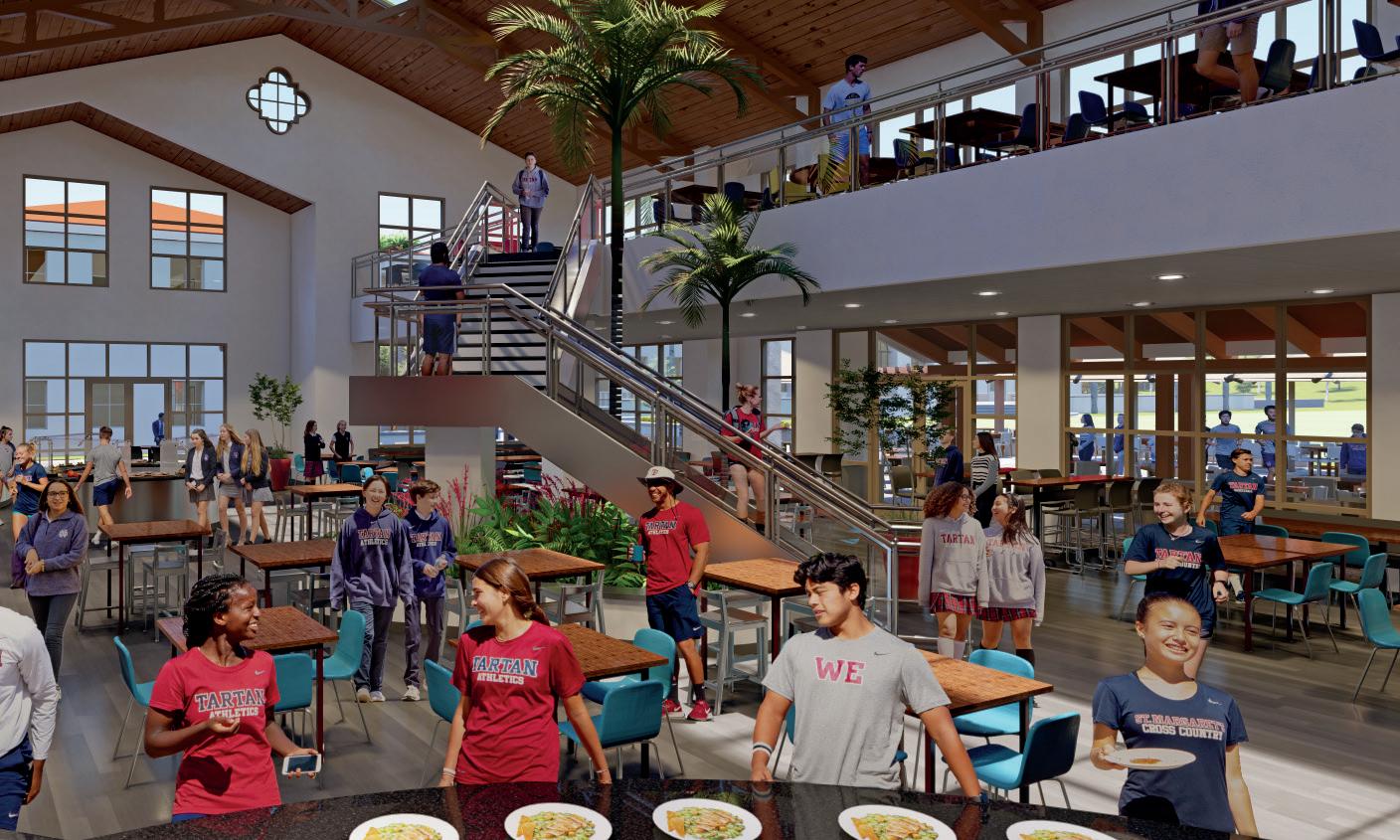
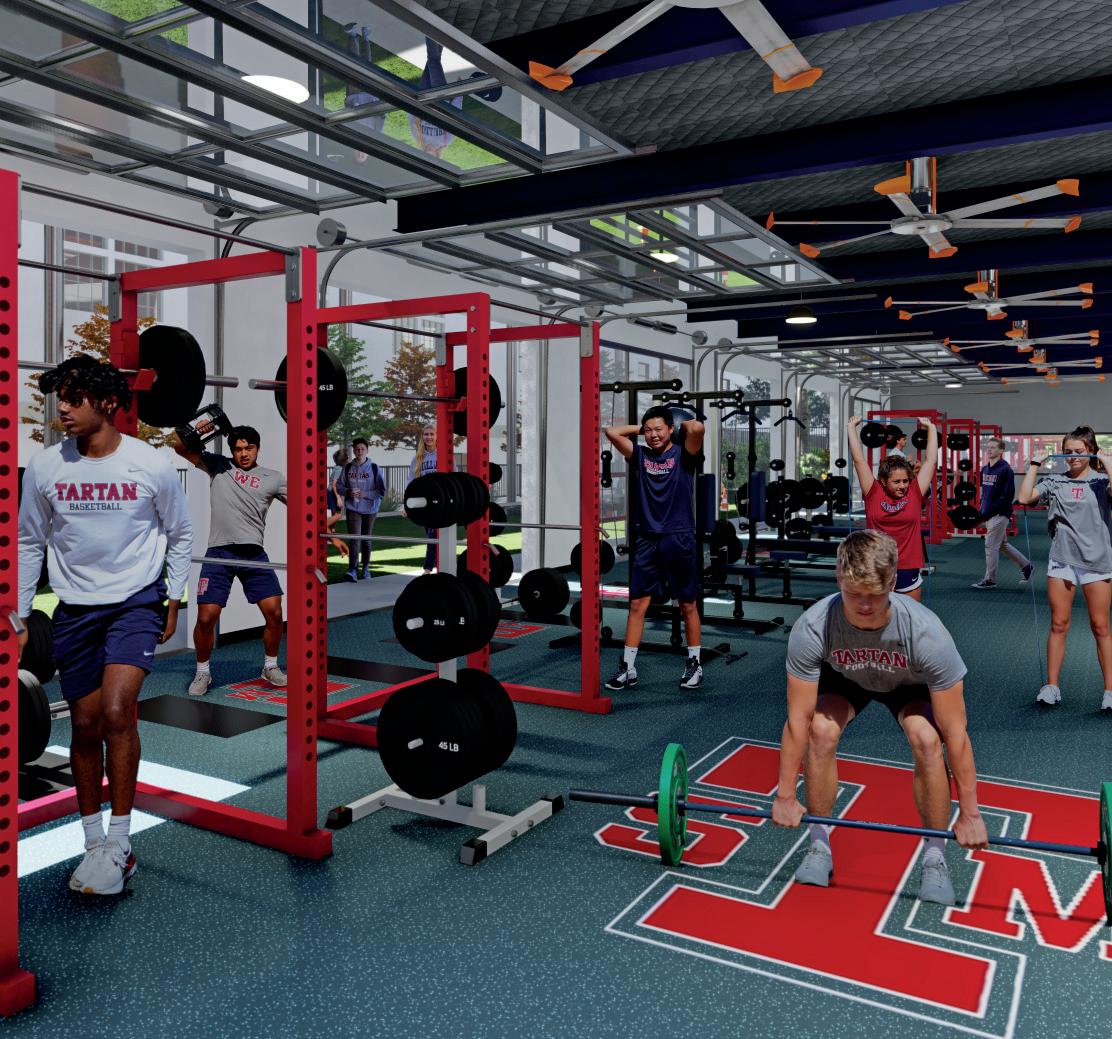
A MODERN, FULLY EQUIPPED STRENGTH AND PERFORMANCE FITNESS CENTER, twice the size of the school’s current facilities, will support the expanding personal fitness and wellness program and the training of all Tartan athletes. “The Commons will be a transformational addition to the student experience of every Tartan, providing community gathering spaces and innovative resources for Tartans to come together for learning, personal wellness and friendship,” Board of Trustees President Paul Westhead and Head of School Will Moseley said in a joint message. “The Student Commons satisfies the greatest need in our campus planning, and the most significant investment we can make to advance our health and wellness initiatives for all Tartans and for generations to come.” St. Margaret’s has expanded health and wellness initiatives for students over the past five years. The timing of this relaunch is also underscored by the physical and mental health challenges that were brought to the forefront of the nation by the pandemic, especially for young people. “After the past two years we’ve experienced, we wish to emerge with a renewed commitment to the importance and value of health and wellbeing for students and our entire community. In line with our mission to educate the hearts and minds of students for their whole lives, we aim to nurture well-being, purpose and happiness in our students today and in the future. Through fitness, nutrition, a balanced daily schedule, healthy habits and life skills, these initiatives further supported and advanced by the Student Commons will fuel our students’ growth and learning today and carry into their adulthood, setting them up for successful and happy lives,” said Mr. Moseley. Much of the foundational work for the Commons has already been accomplished behind the scenes. The first phase of facility needs assessment and planning, as well as architectural designs, have been achieved by the Board of Trustees and the administration with the input of members of the professional community who will directly use the facility for their student programs. Students were also engaged and will continue to be involved with providing input about their needs through ethnographic interviews and research, which are integral to St. Margaret’s Innovation Strategy process. Initial kitchen and dining plans for food and meal preparation and service have been created with the input of third-party food service leaders, which the school will eventually contract to work on-site running dining operations for St. Margaret’s. These plans are currently being reviewed to incorporate new food service considerations learned over the course of the pandemic. In the fall of 2019, St. Margaret’s acquired additional land and properties in the Ortega Village Center, a milestone development in the school’s long-term campus master planning that supports strategic priorities. The acquisition included three buildings immediately adjacent to campus— two buildings closest to campus next to St. Margaret’s Wallace Hall that also border the Upper School, and the center two-story office building that is directly across the parking lot from the Middle School. This added approximately five contiguous acres to the campus, providing the foundation for future development, including reallocating existing campus space where Wallace Hall sits today. Another step was accomplished in the summer of 2021, when administration offices that were located in Wallace Hall moved to offices in the newly renovated St. Margaret’s Ortega Village Center Office Building.
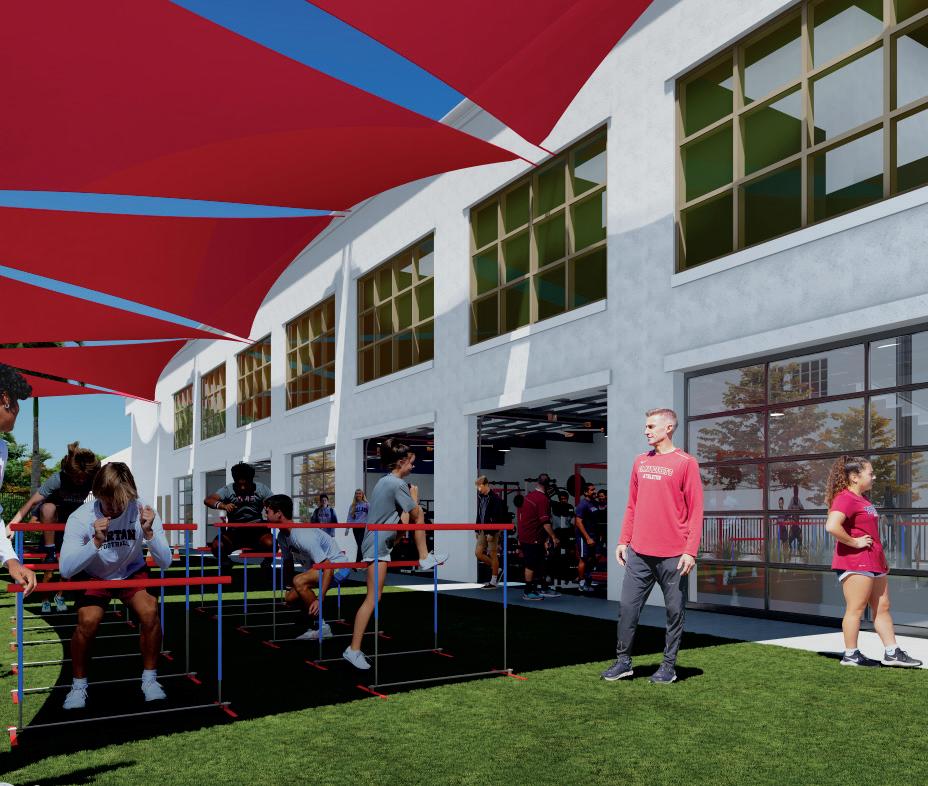
RAISING THE FUNDS In relaunching the project, Mr. Westhead says, it is important to remind the community that these capital development projects are not funded with tuition dollars. “The school’s capital projects, like the Performing Arts Center completed in 2012, Maseeh Middle School completed in 2015, and Johnson Wallis Visual Arts Center completed in 2017, are funded through generous donations from community members. It is a testament to our school’s clear mission and the support and generosity of our community,” said Mr. Westhead.
A number of donors have already supported the quiet phase of the campaign with early leadership gifts. More information about these gifts and next steps will be announced at the 2022 Forever Plaid: All Hallows’ Evening on October 29 at A/V Irvine. All member of our community are invited and encouraged to attend. The first public gift to the project was announced in the spring of 2022: a $500,000 gift from the St. Margaret’s Parent Teacher Fellowship. With this early community excitement, and significant support from the Board of Trustees and lead donors, St. Margaret’s is able to now initiate a school-wide fundraising effort. “We are deeply grateful for our leadership donors of the Student Commons project, as well as our entire community for your commitment and partnership as we continue to move St. Margaret’s forward,” Mr. Westhead said.
The school projects an 18-month construction timeline for the Student Commons that would move forward based on meeting capital fundraising parameters established by the Board of Trustees and construction permitting. The Board of Trustees and administration will provide more details and hold information sessions on the Student Commons and capital campaign fundraising for parents this fall.
Scan here to learn more about the Student Commons and see launch film with more renderings. To attend an information session or get involved in the Student Commons project, please contact Executive Director of Advancement Jonathan Tufo at jonathan.tufo@smes.org.
BY STEPHANIE HOBACK, Director of Annual Giving, & JONATHAN TUFO, Executive Director of Advancement
phi·lan·thro·py:
The effort to increase the well-being of humankind, as by charitable donations. From the Greek philanthrōpos meaning love of mankind.
It is hard to imagine a more powerful team than school and parents working together for the good of children. At St. Margaret’s Episcopal School, one of the many ways in which we work together is through philanthropy. Your gifts support the people and programs that make St. Margaret’s so special. You further our efforts to accomplish our strategic initiatives and remind us that fulfilling our mission and vision requires more than tuition alone. At St. Margaret’s, we have a responsibility to elevate the student experience, and your philanthropy is a testament to that responsibility. Together, we make a collective investment in each and every Tartan, who in turn make the world a better place. There are many opportunities to philanthropically support our Tartan community. Here are some ways you can do so this year:
THE ANNUAL FUND
The Annual Fund is the single most important annual fundraising opportunity. Gifts to the Annual Fund support every aspect of the student experience, from faculty excellence and technology to program enhancements. The Annual Fund directly impacts every aspect of the school and each student’s experience. It provides for the margin of excellence in all that we do. The school depends on the Annual Fund to contribute approximately 4% of the operating budget, which translates to $1.2 million this school year. The Annual Fund helps us to moderate tuition increases, which in turn promotes a diverse student body and maintains a tuition that is competitive with our peer schools. All gifts to the Annual Fund are tax-deductible.
The participation of our entire community is critical to the success of our work, regardless of the amount of the gift. Every student benefits from the Annual Fund. Community support for the Annual Fund reflects the strong culture of philanthropy at our school. Participation is a metric that is used nationally and most easily signifies confidence in the school. Strong parent participation can be an indicator for foundations and other organizations that are considering a gift to St. Margaret’s. Our goal is to reach 100% every year. PARENT TEACHER FELLOWSHIP (PTF)
The mission of the PTF is to offer cultural, physical, spiritual and educational enrichment to the students, teachers and families of St. Margaret’s Episcopal School through community-building and fundraising. All PTF activities are conducted in accordance with policies and protocols adopted by St. Margaret’s Episcopal School.
PTF programming includes community-building events, appreciation gifts and program administration. Additional funds are raised through the following events:
Forever Plaid All-School Fundraiser – Bringing the entire St. Margaret’s community together, the Forever Plaid Fundraiser provides for an evening of fine dining and dancing to live music. Exciting live and silent auction items are also available. This is our primary fundraiser of the year and all proceeds benefit the school. Online Auction – The PTF Online Auction consists primarily of priceless teacher/student experiences donated by our generous professional community. Student-centered items will be available for bidding by parents in every school division. All funds raised go directly to the PTF Grant Enrichment Program. Library Luncheon – The Library Luncheon is the longest timehonored event sponsored by the PTF and is held every spring, celebrating our love for good books and good friends. Tables are decorated by parent hostesses and the PTF to perfection, and all guests enjoy an afternoon of camaraderie and fellowship. All proceeds benefit the library and the PTF Grant Enrichment Program.
1
2
3
CAPITAL GIVING
Capital gifts are larger, less frequently made gifts intended to have a significant impact on the school’s physical plant and facilities or endowment. The school will occasionally solicit these gifts for a specific building project or during a capital campaign. Multiyear pledges are commonly made as capital gifts.
Capital Construction Projects — The next building project for St. Margaret’s is the Commons. It will serve as the home and physical manifestation of the health and wellbeing strategic initiatives underway. Learn more about the Commons project on page 22.

THE ST. MARGARET’S ENDOWMENT
The St. Margaret’s Endowment is a pool of funds invested for the longterm, where the corpus of the funds are perpetually used to generate capital gains and interest income to support the annual operating budget and some specific initiatives. Endowment is essential to the school's health and sustainability. Many school fundraising initiatives contribute 20 percent of funds to the endowment.
TARTAN ALUMNI LEGACY ENDOWMENT (TALE)
A restricted endowment to support the school’s Financial Aid program. Alumni and parents of alumni help to support and grow this fund annually.
TARTAN OPEN
Golf tournament to raise funds for need-based financial aid.
BREAKTHROUGH SAN JUAN CAPISTRANO
Breakthrough San Juan Capistrano is breaking the cycle of poverty through the power of education by serving students from underrepresented backgrounds starting in middle school through college graduation. Breakthrough supports students from middle school to college graduation through tuition-free, college access programming. Nearly all Breakthrough SJC students are from low-income backgrounds and will be the first in their families to graduate from college (read more on page 26).
SPECIAL CAMP
Founded by Father Mike Wallens in 1992 to address the scarcity of resources for school-age children with disabilities in the community. With service, opportunity and love, we will continue to work toward inspiring future generations to eliminate the stigma associated with this beautiful community. (read more on page 10).
Scan here to learn more about our fundraising initiatives and determine how you can support our community this year. We are honored by your trust and look forward to engaging in a philanthropic partnership.
Through generous donors, we are able to support St. Margaret's in many ways, from enriching the daily academic environment to special programs like Breakthrough and Special Camp
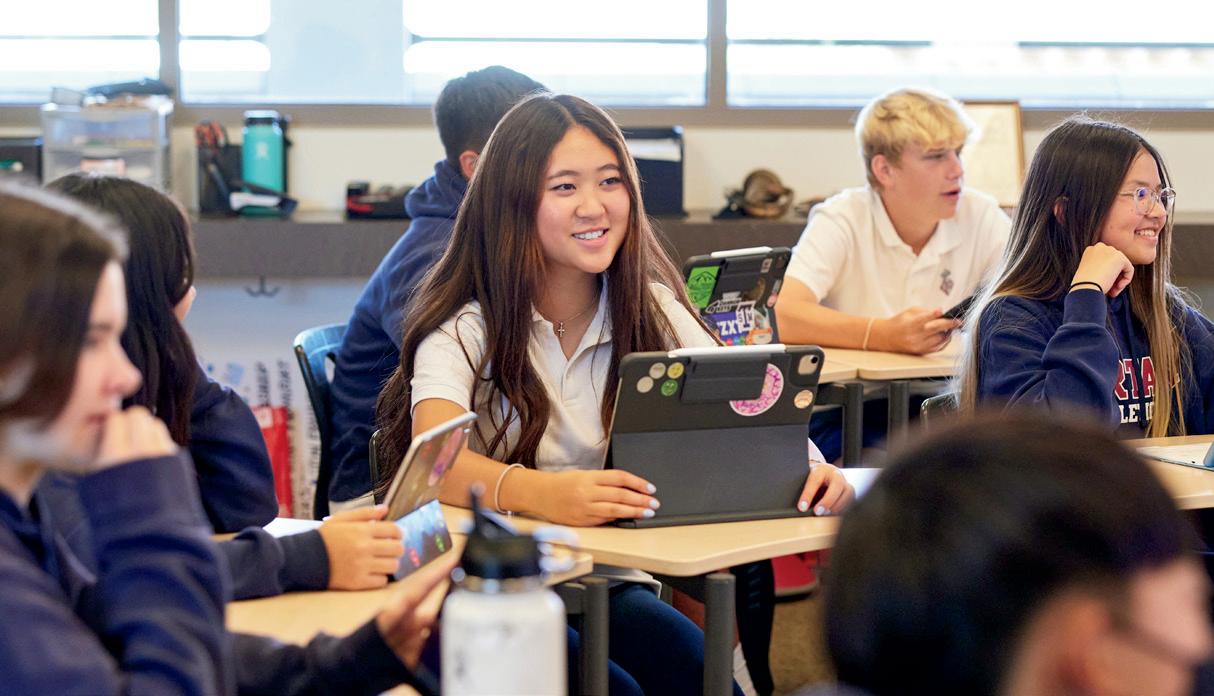


A YEAR OF GIVING
2022-2023 nov. 28
ANNUAL FUND KICKOFF
Oct. 29
FOREVER PLAID: ALL HALLOWS' EVENING
Mar. 1
ONLINE AUCTION
APR. 1
PTF 41ST ANNUAL LIBRARY LUNCHEON
May 1
TARTAN OPEN
Ongoing GIVING
CAPITAL PROJECTS ENDOWMENT BREAKTHROUGH SPECIAL CAMP
Home town Hero
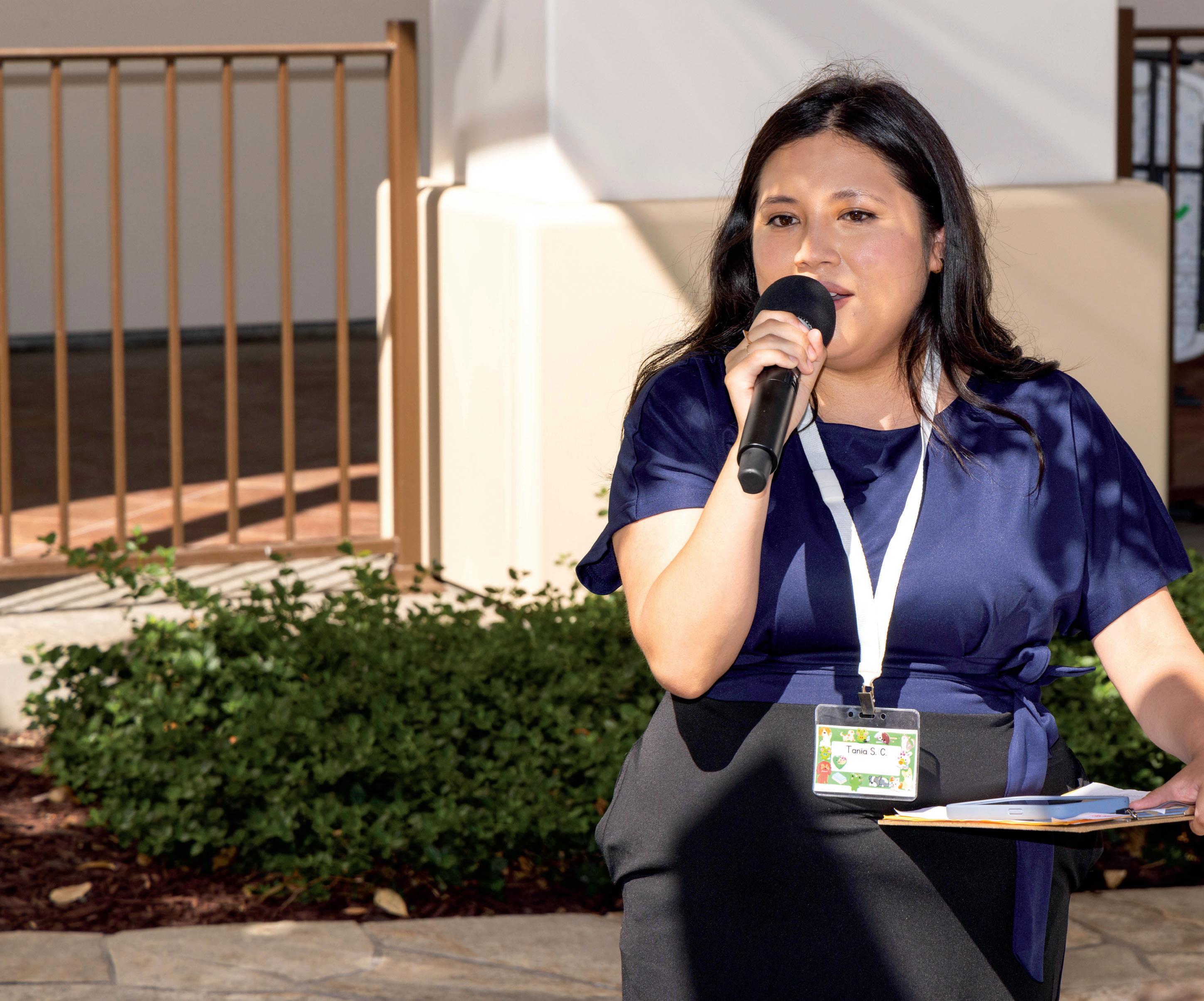
Breakthrough SJC Alumna Tania Solano Cervantes Returns as Program’s Assistant Director
BY ANNE DAHLEM
Breakthrough San Juan Capistrano this spring announced the appointment of Tania Solano Cervantes as Assistant Director of Middle School and Early High School programs, overseeing all elements of the academic enrichment program for its students in grades 7–10.
As a longtime Breakthrough SJC participant, Ms. Solano Cervantes brings unique skills, insights and experience to this role. Growing up in Dana Point, she attended Marco Forster Middle School and graduated from Dana Hills High School. Ms. Solano Cervantes is an alumna of Breakthrough SJC as a student and has served for the past four years in leadership and mentoring roles, as a tutor, summer volunteer coordinator, teaching fellow and dean of students. “Tania is a Breakthrough SJC success story in every way. She has quite literally walked in the very same path as our students and teaching fellows. She brings extraordinary perspective, personal understanding of our local community and organizational culture, and possesses a profound passion for the power of education and importance of equal access,” said Breakthrough SJC Director Elizabeth Eusebio. “We are incredibly proud and excited to have Tania joining Breakthrough as a full-time member of the team helping to guide the program and further mentor our students with her deep knowledge and exceptional talent and skills.”
A tuition-free program supporting local motivated students whose backgrounds are underrepresented in higher education, Breakthrough provides academic programming and guidance from middle school
through college graduation for students primarily from lowincome households. Breakthrough is hosted and sponsored by St. Margaret’s and serves students in and around the San Juan Capistrano community.
“Breakthrough has had a tremendous impact on my educational journey—from my years as a middle school student of the summer program to now. I am the first in my family to graduate from college and breaking the cycle of poverty for my family. This is truly an indication of the impact that Breakthrough has on first-generation students like me,” she said. “I am honored that Breakthrough SJC has trusted me as the right person to assume the role of Assistant Director of Middle School and Early High School for Breakthrough San Juan Capistrano.”
Ms. Solano Cervantes was part of the graduating Class of 2022 from the University of California, Los Angeles, earning Bachelor of Arts in political science and a minor in labor studies, with academic honors.
Her relevant experience extends beyond Breakthrough, as well. Since 2020, she has served as an AB540 project director at UCLA for IDEAS (Improving Dreams, Equity, Access, & Success), a support program for immigrant students. She also completed coursework in immigrant rights, labor and higher education. These experiences have further shaped her perspective, skills and expertise to support first-generation students and immigrant-based, workingclass communities.
St. Margaret’s Director of Equity and prior Breakthrough SJC director Victor Cota said, “One of my favorite things about St. Margaret’s is our commitment to the local community, especially through our outreach programs, Special Camp and Breakthrough SJC. Tania’s hiring is yet another incredible example of St. Margaret’s and Breakthrough’s missions in action. Seeing Tania grow in the program as a student into the amazing adult and educator she is today, is a full-circle moment for me and the work we do through Breakthrough. As Tania takes over the programming for Breakthrough’s seventh through 10th graders, she will tap into her own lived experiences and guide these young people on their own paths to and through college as an authentic role model they can look up to. This is exactly what Breakthrough is all about!”
Ms. Solano Cervantes is passionate about Breakthrough’s purpose and impact on young people. “Coming from an immigrant, workingclass background, I have learned to overcome the systemic barriers that made my pursuit of higher education difficult. This achievement would not have been possible without the support of communities like Breakthrough, which have paved a pathway for my success. The commitment that Breakthrough SJC demonstrated to me, and countless other students, has ultimately instilled in me the values and passion for achieving social justice and advocating for educational equity,” Ms. Solano Cervantes said.
“As the new Assistant Director, I will continue to ensure that underrepresented students are not left outside the pathway for higher education by addressing the barriers that except them, and making all students and their families feel valued and included. I look forward to working with staff, students and families as we continue serving and empowering the next generations of Breakthrough college graduates.” The appointment of Tania Solano Cervantes as
Breakthrough San Juan Capistrano’s assistant director is just one significant change in the program’s leadership recently.
Elizabeth Eusebio just completed her first full year as Director of Breakthrough SJC. She, too, is a local success story—a firstgeneration college graduate from Santa
Ana whose path to graduation is a source of inspiration for current Breakthrough students.
Ms. Eusebio often shares her story as the daughter of immigrants in a Spanish-speaking home who earned her bachelor’s degree at Cal State-Fullerton, followed by a masters degree from Chapman University. She joined Breakthrough after working as a behavioral therapist in the Garden Grove Unified School District and as an educator and inclusion specialist at a charter school in Riverside.
“We’re striving to make our programs stronger, more accelerated, more impactful,” Ms. Eusebio said. “I’m excited to see where we can take this.”
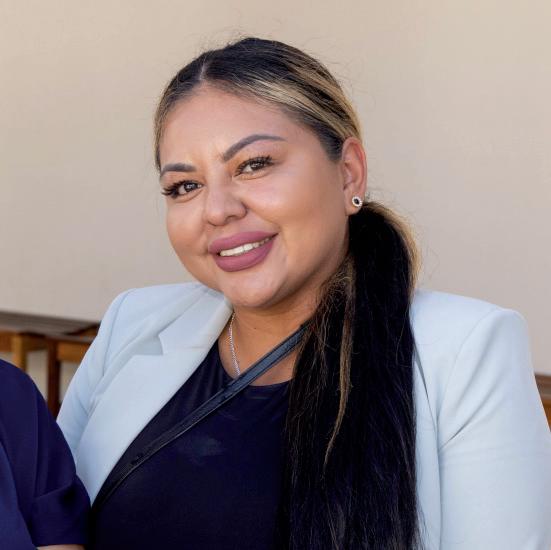
359 Students Served
86% ARE THE FIRST IN THEIR FAMILIES TO ATTEND COLLEGE
94% IDENTIFY AS A STUDENT OF COLOR
91% QUALIFY FOR FREE OR REDUCED LUNCH
89% ENGLISH IS NOT THE PRIMARY LANGUAGE AT HOME
100% 88%
ADMITTED TO A FOUR-YEAR COLLEGE OR UNIVERSITY
Elizabeth Eusebio Completes First Year as Breakthrough SJC Director
> Scan here to read the Winter 2022 Highlander feature on Elizabeth Eusebio
Class of 2022
124 74

CLASS OF 2022 GRADUATES ARE ATTENDING COLLEGES AND UNIVERSITIES IN

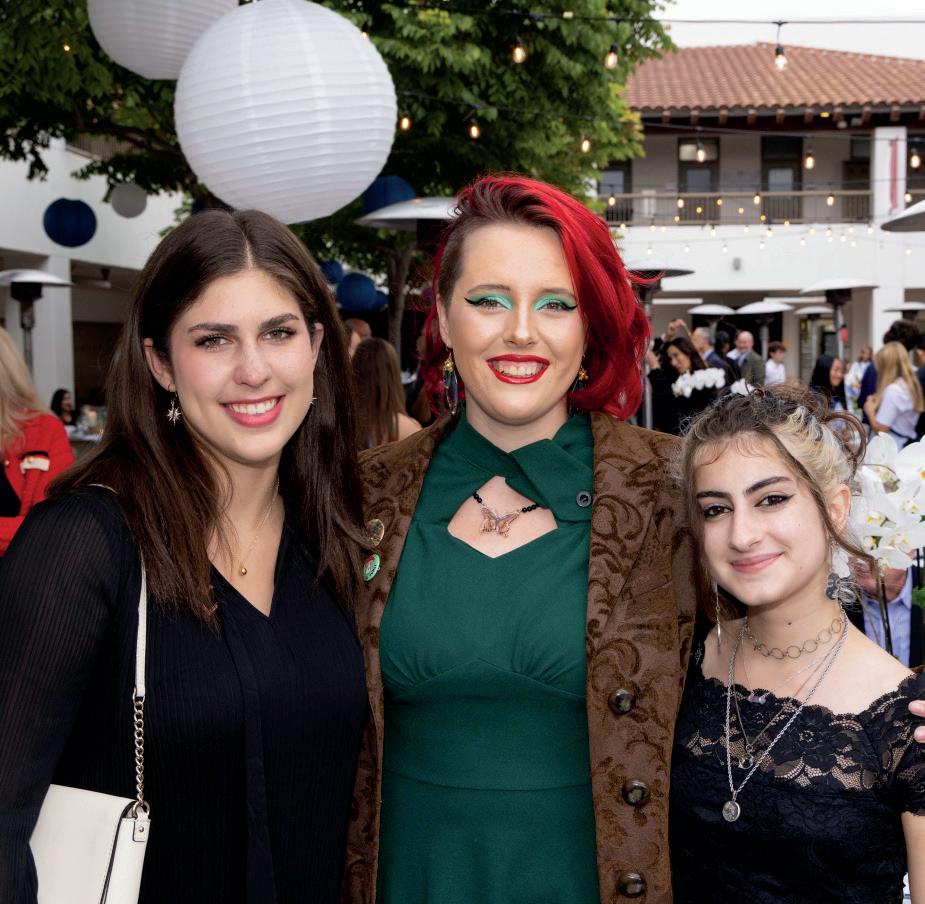
24
STATES AND
1
COLLEGE ABROAD (SWITZERLAND)
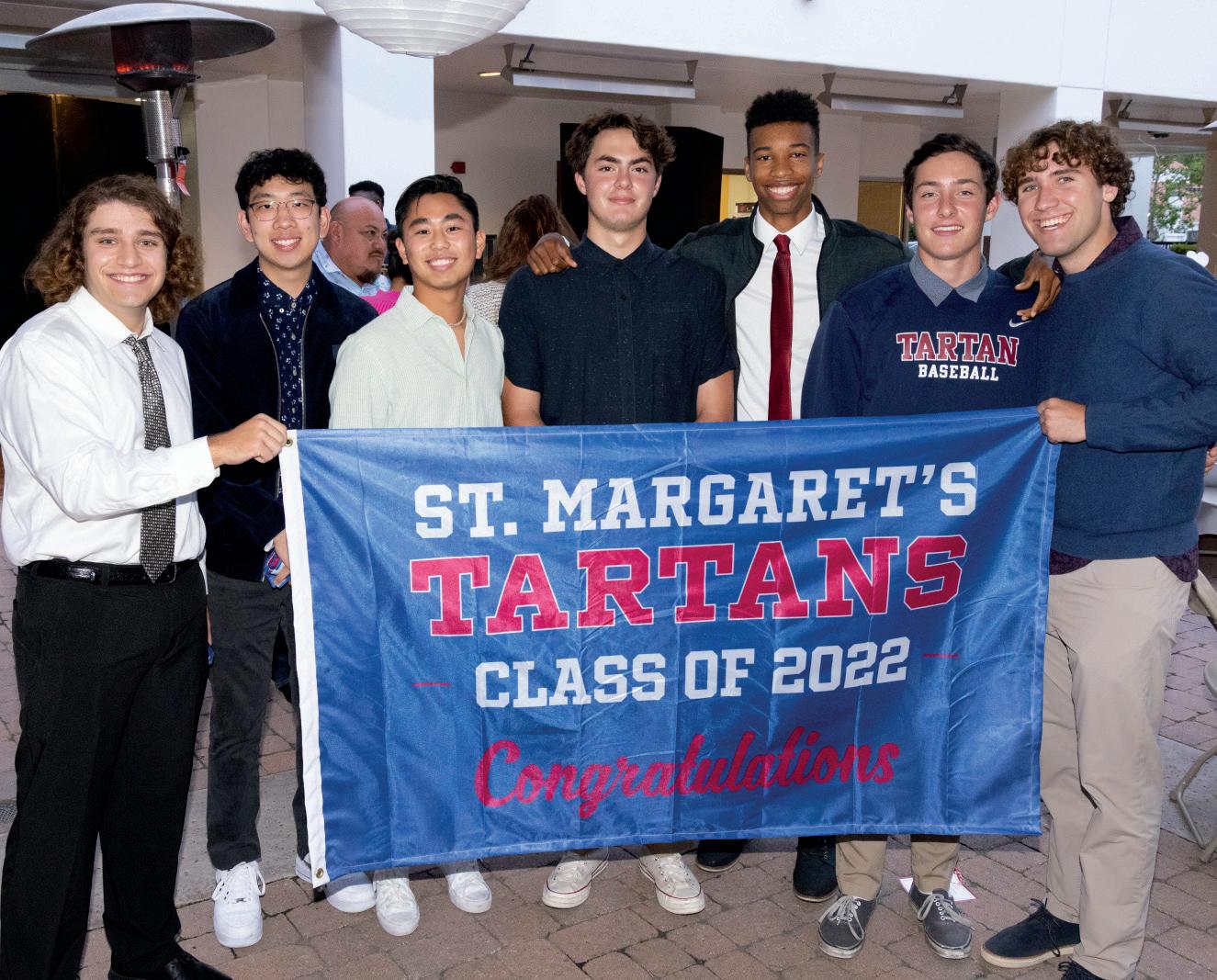

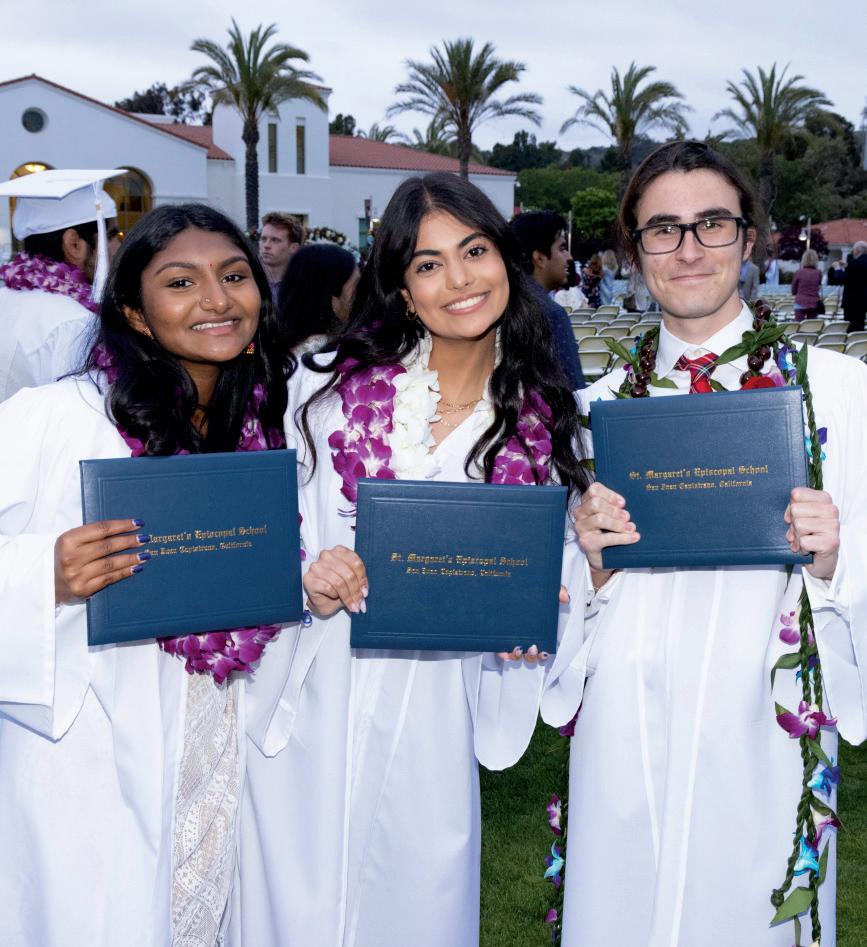
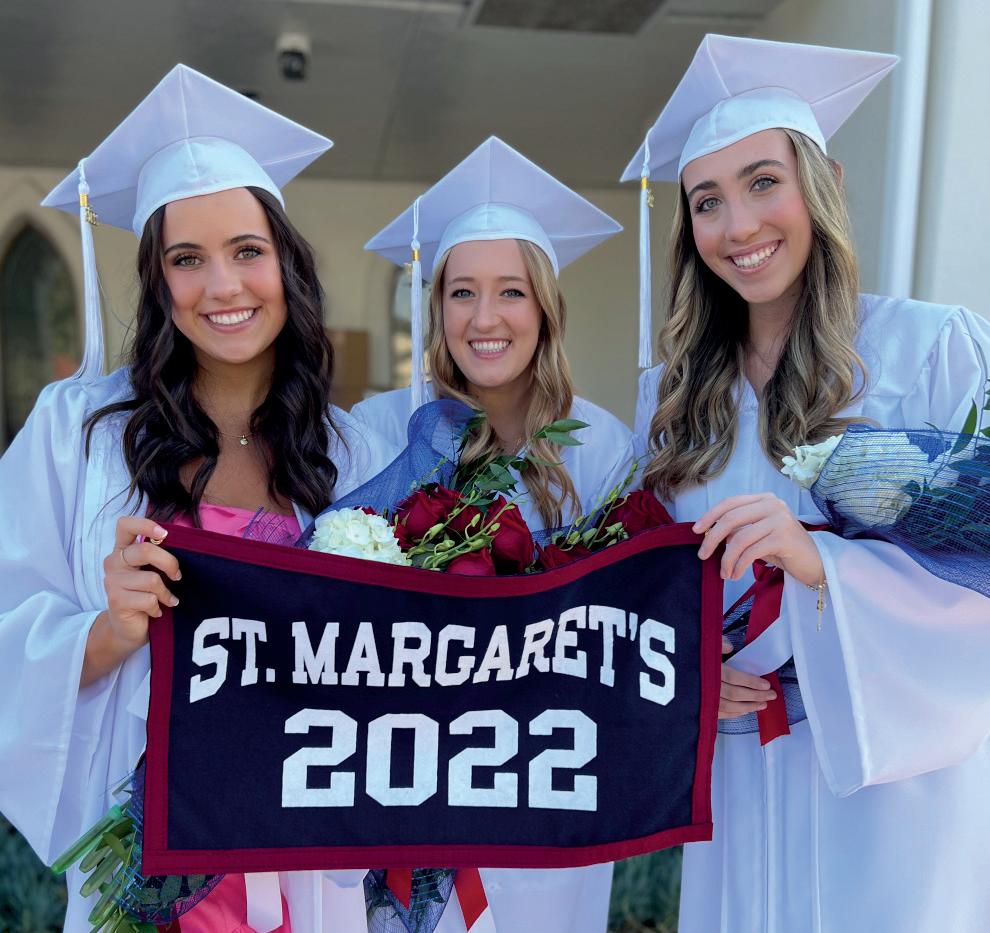
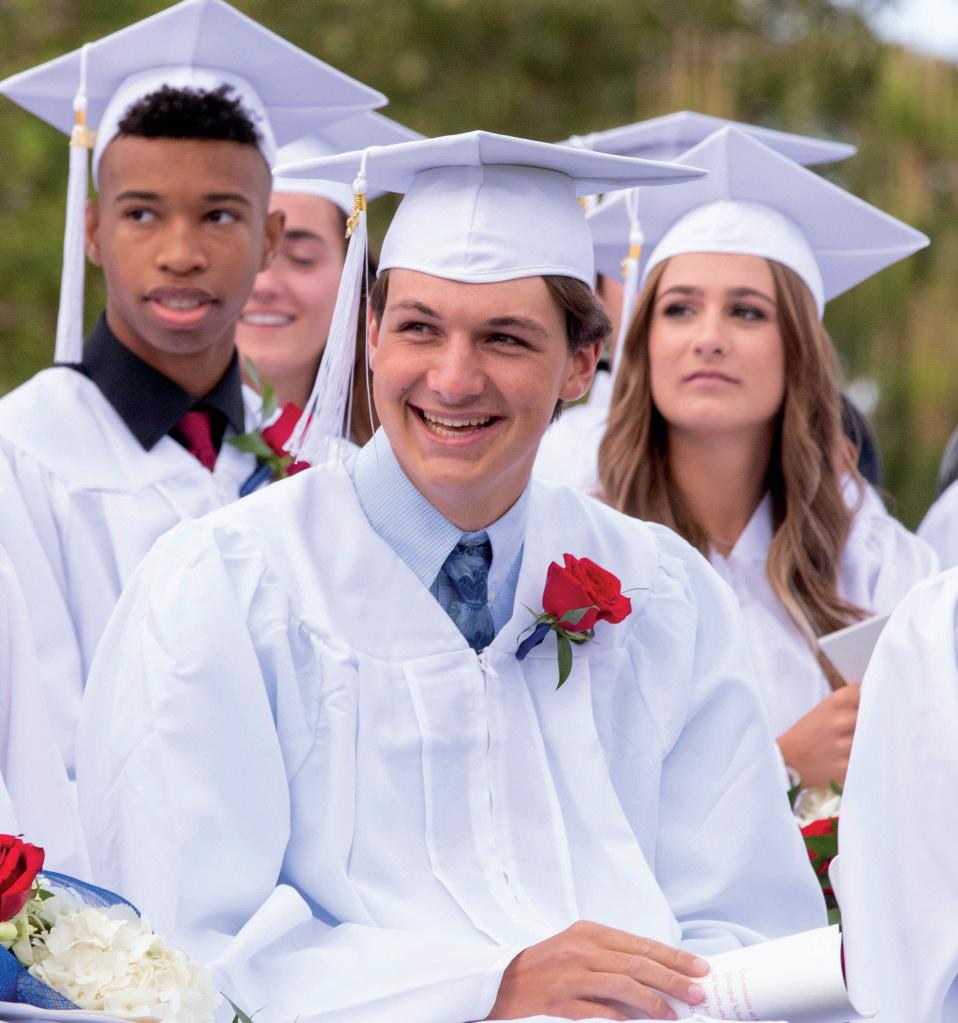


19
PLAN TO COMPETE IN INTERCOLLEGIATE ATHLETICS
6
PLAN TO MAJOR OR MINOR IN AN ARTS-RELATED DISCIPLINE SCAN HERE for complete speeches and photo galleries from Commencement 2022.


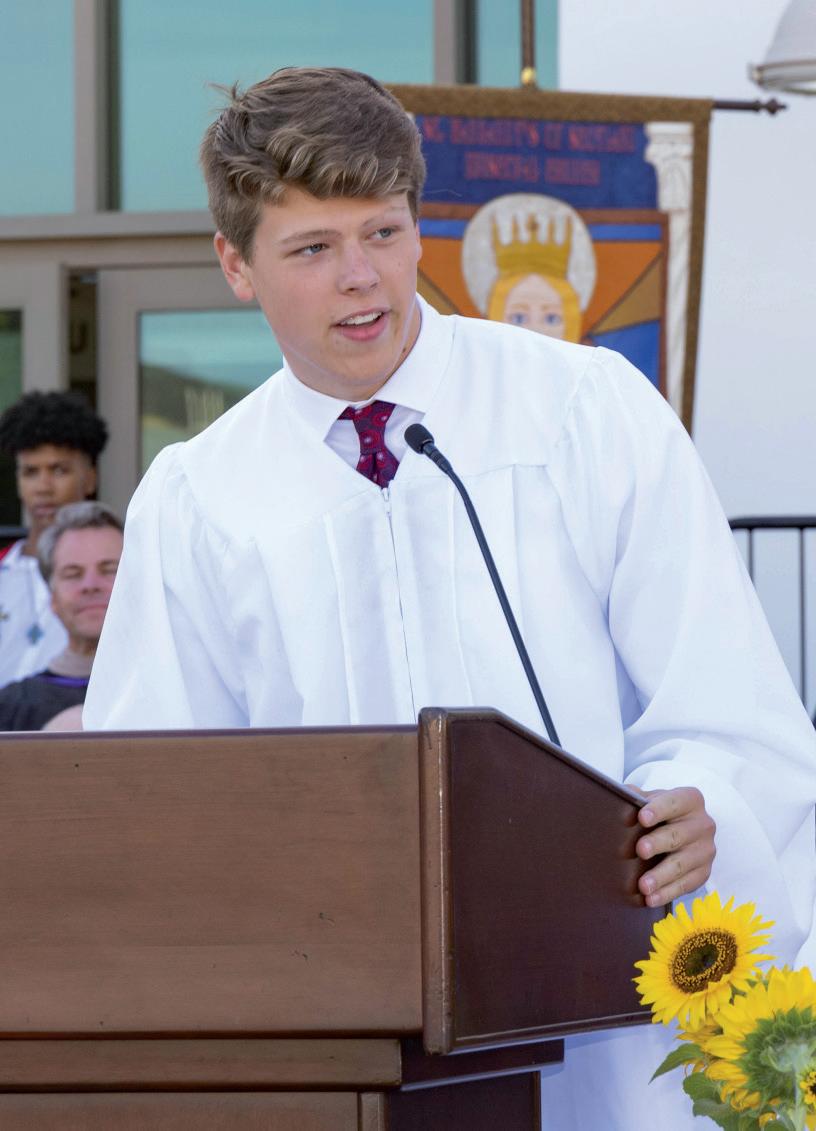

Class of 2022
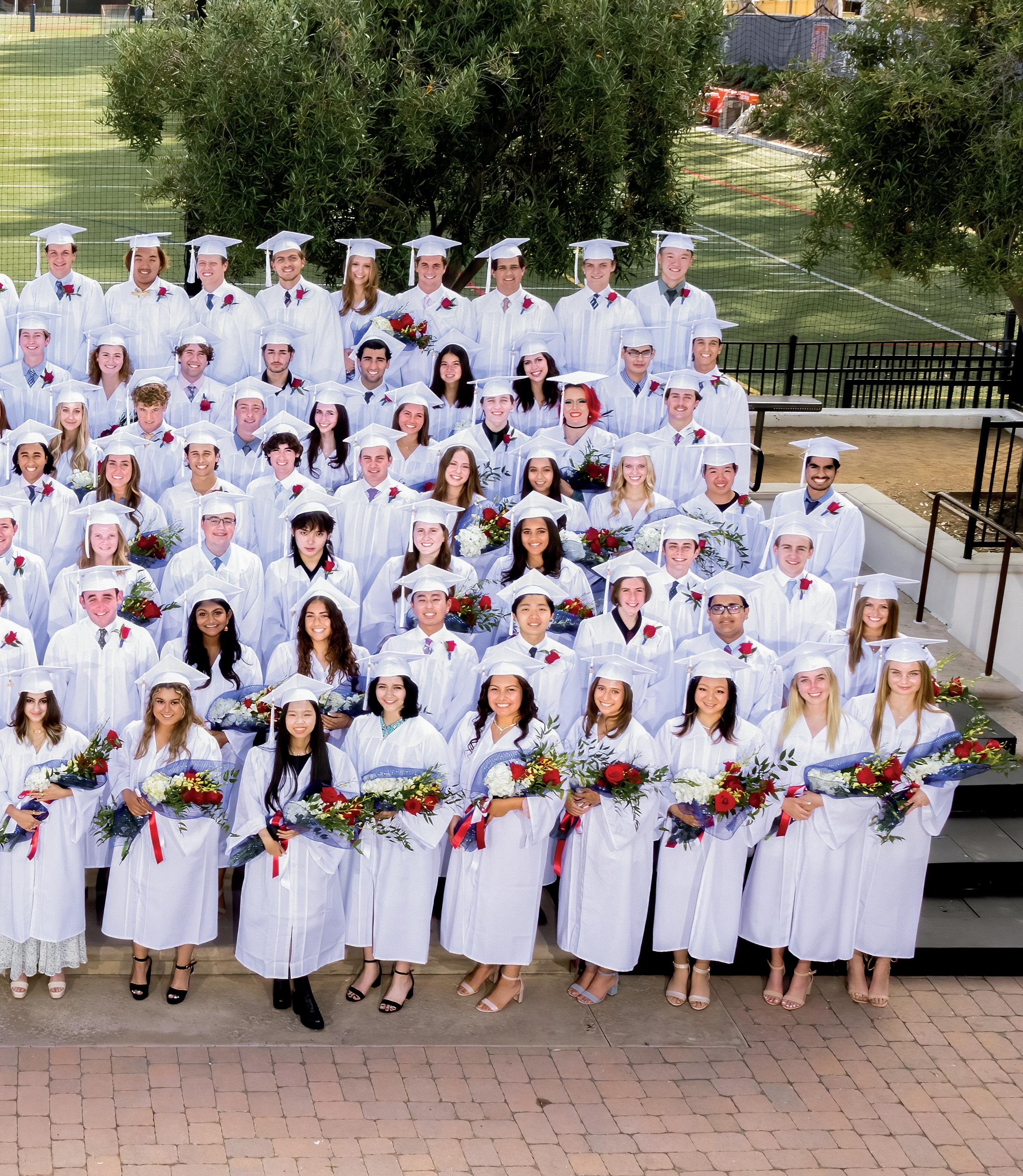
CLASS OF 2022 GRADUATES ARE ATTENDING THE FOLLOWING COLLEGES & UNIVERSITIES

Arizona State University Babson College Bard College Barnard College (2) Bates College Baylor University (3) Bentley University Boston College Boston University Bryant University Cal State Maritime
Chapman University (6) Clemson University (2) Colby College College of the Holy Cross Dartmouth College Denison University Drexel University Emory University Franklin & Marshall College Franklin College of Switzerland George Washington University Georgetown University Harvey Mudd College Hofstra University Johns Hopkins University Loyola Marymount University (3) Loyola University Chicago Michigan State University Monmouth University (2) New York University (4) Northeastern University Northwestern University (2) Pennsylvania State University Purdue University (2) Reed College (2) Rhodes College Rollins College Rose-Hulman Institute of Technology Saddleback College (3) Santa Clara University Southern Methodist University (4) St. Olaf College Syracuse University Texas Christian University (2) The New School
Trinity College Tulane University (3) University of California, Berkeley University of California, Irvine (3) University of California, Los Angeles (3)
University of California, Riverside University of California, San Diego (4) University of California, Santa Barbara University of Chicago (3) University of Colorado, Boulder University of Illinois, Urbana-Champaign University of Miami (2) University of Michigan University of Oregon University of Pennsylvania University of San Diego (5) University of Southern California (5) University of Tennessee (2) University of Texas, Austin University of Utah (3) University of Washington University of Wisconsin United States Military Academy at West Point
Vanderbilt University Virginia Military Institute Wellesley College (2) Westmont College Willamette University William & Mary College (2) Yale University
Congratulations

CLASS OF 2029
Students in the Class of 2029 officially celebrated the completion of Lower School with a ceremonial tossing of their Lower School red sweaters. The students were led out to Chalmers Field by their parents and younger Lower School students, who clapped them out in a final farewell.

and
CLASS OF 2026
Students in the Class of 2026 finished their years in the Middle School and were promoted to the Upper School during a ceremony on Chalmers Field in June. The ceremony featured remarks from Middle School Assistant Principal Mike Allison, a speech from Middle School student council president Jack Klausner, and a presentation of certificates to the 113 students in the grade 8 class.
